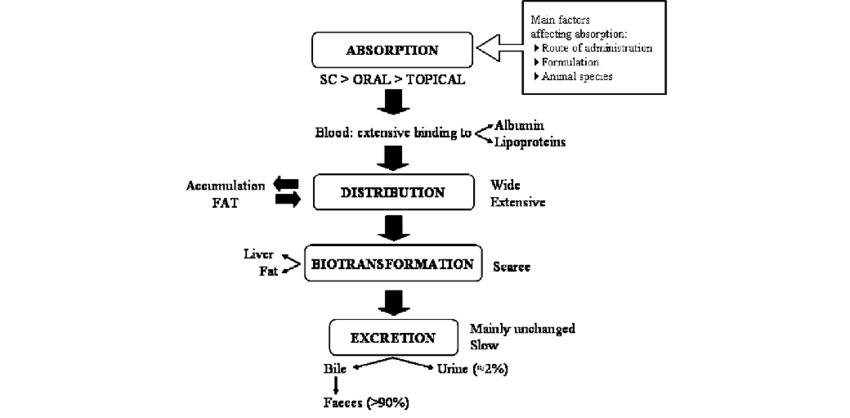📘 قراءة كتاب Comparative pharmacokinetics of ivermectin after its subcutaneous administration in healthy sheep and sheep infected with mange أونلاين


Comparative pharmacokinetics of ivermectin after its subcutaneous administration in healthy sheep and sheep infected with mange من كتب طب بيطرى
Comparative pharmacokinetics of ivermectin after its subcutaneous
administration in healthy sheep and sheep infected with mange
J. ECHEVERRI
́
A*
,
N. MESTORINO*
,
&
J. O. ERRECALDE*
,
*Ca
́
tedra de Farmacologı
́
a, Farmacotecnia y Terape
́
utica, Facultad de Ciencias Veterinarias, Universidad Nacional de La Plata, La Plata,
Argentina;
INCAM, Vero
́
nica Experimental Station, La Plata, Argentina;
(Paper received: 21 March 2001; accepted for publication 19 November 2001)
Correspondence (e-mail: jerrecal@fcv.unlp.edu.ar)
It is well established that the efficacy of any anthelmintic drug
depends not only on its affinity for specific parasite target sites
but also on its ability to reach high and sustained drug
concentrations where the parasites are located.
Ivermectin is one of the most useful anti-parasitic agents. It
belongs to the family of avermectins that are highly lipophilic
macrocyclic lactones. It is a fermentation product of
Streptomyces
avermitilis
. One of the most important characteristics of iver-
mectin is its wide spectrum of activity involving endo- and
ectoparasites.
Ivermectin is effective when it is applied orally, parenterally or
topically. Its absorption is rapid by any of these routes of
administration (Campbell, 1989, 1993).
Mange is an ectoparasitic disease produced by the mite
Psoroptes ovis
. It has major economic importance in South
America, especially Argentina, Chile and Uruguay. It is antici-
pated that in the diseased animal there are kinetic modifications
largely dependent on the change of body condition. The objective
of the present paper was to determine the pharmacokinetic
changes of ivermectin when applied subcutaneously to healthy
animals and animals carrying natural mange infections.
Six adult and healthy sheep (weighing 50 ± 6 kg) and five
sheep naturally infested with psoroptic mites and showing
mange lesions on at least 30% of their body surface (weighing
43 ± 6 kg) received 200
l
g/kg ivermectin subcutaneously, the
sampling times being at the following post-administration days:
0.5, 1, 2, 3, 4, 6, 8, 10, 12, 15, 18, 20, 25 and 30. Plasma was
separated by centrifugation and kept frozen at
)
20
°
C until
assayed. Assay was performed by high-performance liquid
chromatography (HPLC). The recovery was 85% and the
quantitation limit was 0.1 ng/mL. Variability was lower than
8%. The HPLC system was a Shimadzu LC-10 AS pump and TM
III 1311 model fluoromonitor. The column was a C8 reverse
phase lichrospher and the mobile phase was glacial acetic acid/
methanol/acetonitrile (9:200:291 mL) at a flow rate of 1.5 mL/
min. Reagents were HPLC grade. Extraction was accomplished
by the solid–liquid method with C18 cartridges. The eluate was
evaporated, derivatizated and injected into the HPLC system
(Alvinerie
et al
., 1987). Pharmacokinetic analysis wa
حجم الكتاب عند التحميل : 64.1 كيلوبايت .
نوع الكتاب : PDF.
عداد القراءة:
اذا اعجبك الكتاب فضلاً اضغط على أعجبني و يمكنك تحميله من هنا:

شكرًا لمساهمتكم
شكراً لمساهمتكم معنا في الإرتقاء بمستوى المكتبة ، يمكنكم االتبليغ عن اخطاء او سوء اختيار للكتب وتصنيفها ومحتواها ، أو كتاب يُمنع نشره ، او محمي بحقوق طبع ونشر ، فضلاً قم بالتبليغ عن الكتاب المُخالف:
 قبل تحميل الكتاب ..
قبل تحميل الكتاب ..
يجب ان يتوفر لديكم برنامج تشغيل وقراءة ملفات pdf
يمكن تحميلة من هنا 'http://get.adobe.com/reader/'


 منصّة المكتبة
منصّة المكتبة